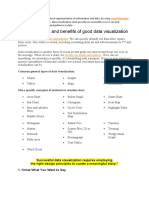0% found this document useful (0 votes)
75 views14 pagesIntroduction To Data Visualization
a presentation file, mainly describing the characteristics and basics of a good graph, and how to present data properly
Uploaded by
m.mandakhbayarCopyright
© © All Rights Reserved
We take content rights seriously. If you suspect this is your content, claim it here.
Available Formats
Download as PPTX, PDF, TXT or read online on Scribd
0% found this document useful (0 votes)
75 views14 pagesIntroduction To Data Visualization
a presentation file, mainly describing the characteristics and basics of a good graph, and how to present data properly
Uploaded by
m.mandakhbayarCopyright
© © All Rights Reserved
We take content rights seriously. If you suspect this is your content, claim it here.
Available Formats
Download as PPTX, PDF, TXT or read online on Scribd
/ 14























































